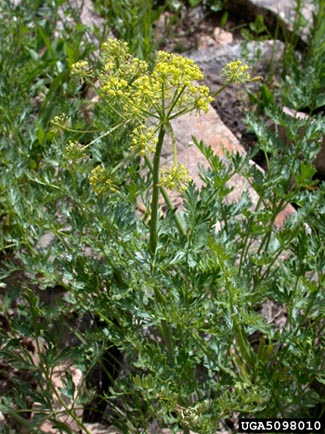Giant Biscuitroot

Common Name(s):
Giant Biscuitroot
Fernleaf Biscuitroot
Giant Lomatium
Giant Desertparsley
Chocolate-tips
Cough Root
Scientific Name:
Lomatium dissectum (Nutt.) Mathias & Constance
Scientific Name Synonyms:
Ferula multifida (Nutt.) A. Gray
Leptotaenia dissectum Nutt.
Leptotaenia multifida Nutt.
Symbol:
LODI
Description:
Life Span: Perennial
Origin: Native
Growth Characteristics: A robust perennial, Giant Biscuitroot is usually 25 – 75 inches tall at maturity. The several stems are usually ascending, rather than strictly erect, from a branching stem base. It grows from a very large, woody taproot. Flowers May to June.
Flowers: Flowers are small, yellow or purple, and arranged in umbels. Flowers contain both male and female organs, but some are always sterile. They are pollinated by insects.
Fruits/Seeds: Elliptic, 8-17 mm long and 4.5-10mm wide. The lateral wings are narrow and more or less socky-thickened, up to about 1 mm wide, the dorsal ribs inconspicuous.
Leaves: Leaves are primarily basal, with a few alternate leaves on stem. The basal leaves are the largest. All leaves are generally slightly rough-textured, seldom hairless. They are pinnately dissected 3-5 times into small and often narrow segments up to 1 cm long. The leaves appear very similar to those you would find on parsley grown in a garden.
Stems: hairless
Ecological Adaptions:
Giant Bisuitroot occurs in sagebrush, pinyon-juniper, oak-maple, aspen-fir, riparian, and rarely greasewood-desert shrub communities. It grows on open, dry, rocky slopes from low to mid elevations. It is not shade tolerant.
Soils: Can grow on a wide variety of soil types, but does require a well-drained soil. It prefers acid, neutral, and alkaline soils.
Associated Species: Aspen, poison hemlock, cow parsnip, pinyon pine, snowberry, big sagebrush.
Uses and Management:
Giant biscuitroot is a highly edible plant. The root can be cooked, or dried and ground into a powder that can then be mixed with cereal flours or added as a flavoring to soups, etc.
Giant biscuitroot was widely employed medicinally by many native North American Indian tribes who considered it to be a universal panacea and used it especially in treating chest problems and skin complaints. It works where other anti-virals fall short. Fresh root (alcoholic) extract is best mode of administration. Giant biscuitroot was used, particularly in the southwestern United States, during the influenza pandemic of 1917 with reportedly good results.
The whole plant, but especially the root, is disinfectant, pectoral, salve, stomachic and tonic.
The dried root was used in the treatment of rheumatism, stomach complaints, coughs, colds, hay fever, bronchitis, influenza, pneumonia and tuberculosis. The root was burnt and the smoke inhaled in the treatment of asthma and other chest complaints, it was also used as an herbal steam bath for treating chest complaints. The root was used to make a drink that was taken as a tonic to help people in a weakened condition gain weight. A poultice of the peeled and crushed roots has been applied to open cuts, sores, boils, bruises and rheumatic joints. The root has been soaked in water and then used as an antidandruff wash for the hair.
An infusion of the leaves and stems has been used as a tonic. The root oil has been applied as a salve to sores and also used as an eye wash in the treatment of trachoma. The pulverized root has been burnt as incense.

